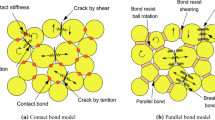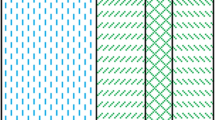Abstract
The rapid development of roads and scenic spots in the suburbs of Beijing has formed a large number of artificial slopes, creating conditions for geological disasters such as collapse. It is urgent to study the influence of joint development and rainfall on the energy evolution mechanism in the process of geological disasters and rock mass failure. The deformation and failure process of jointed rock mass was accompanied by the accumulation and release of energy. To explore the damage anisotropy characteristics and the energy evolution law of jointed rock mass, nuclear magnetic resonance (NMR), triaxial compression, and acoustic emission (AE) tests of rock specimens were carried out. The pore evolution law of jointed rock specimen was analyzed, and the variation law of mechanical parameters and acoustic emission of rock specimen was studied. By establishing the energy evolution constitutive model of jointed rock specimens, the variation laws of total energy, elastic strain energy, and dissipative energy during deformation and failure of jointed rock masses were analyzed, and the energy evolution mechanism during damage and failure of jointed rock masses was revealed. The failure mode characteristics of jointed rock specimens with different dip angles under different confining pressures were analyzed.

















Similar content being viewed by others
Data Availability
The data that support the findings of this study are available from the corresponding author upon reasonable request.
References
Aral İF, Boy R, Dinçer AR (2021) Effects of freeze-thawing cycles on the physical and mechanical properties of basaltic and dolomitic rocks evaluated with a decay function model. Bull Eng Geol Env 80(4):2955–2962
Azizi A, Moomivand H (2021) A new approach to represent impact of discontinuity spacing and rock mass description on the median fragment size of blasted rocks using image analysis of rock mass. Rock Mech Rock Eng 54(4):2013–2038
Dychkovskyi R, Shavarskyi I, Saik P, Lozynskyi V, Falshtynskyi V, Cabana E (2020) Research into stress-strain state of the rock mass condition in the process of the operation of double-unit longwalls. Min Miner Depos 14(2):85–94
Galindo RA, Millán MA (2021) An accessible calculation method of the bearing capacity of shallow foundations on anisotropic rock masses. Comput Geotech 131:103939
Ghorbani M, Shahriar K, Sharifzadeh M, Masoudi R (2020) A critical review on the developments of rock support systems in high stress ground conditions. Int J Min Sci Technol 30(5):555–572
Gomes GJ, Forero JH, Vargas EA Jr, Vrugt JA (2021) Bayesian inference of rock strength anisotropy: Uncertainty analysis of the Hoek-Brown failure criterion. Int J Rock Mech Min Sci 148:104952
Heap MJ, Villeneuve M, Kushnir AR, Farquharson JI, Baud P, Reuschlé T (2019) Rock mass strength and elastic modulus of the Buntsandstein: an important lithostratigraphic unit for geothermal exploitation in the Upper Rhine Graben. Geothermics 77:236–256
Karimi-Khajelangi B, Noorian-Bidgoli M (2022) Numerical study of the effect of rock anisotropy on stresses around an opening located in the fractured rock mass. J Petrol Sci Eng 208:109593
Keawsawasvong S, Ukritchon B (2020) Design equation for stability of shallow unlined circular tunnels in Hoek-Brown rock masses. Bull Eng Geol Env 79(8):4167–4190
Khan NM, Ma L, Cao K, Hussain S, Liu W, Xu Y, Gu J (2021) Prediction of an early failure point using infrared radiation characteristics and energy evolution for sandstone with different water contents. Bull Eng Geol Env 80(9):6913–6936
Krzaczek M, Nitka M, Kozicki J, Tejchman J (2020) Simulations of hydro-fracking in rock mass at meso-scale using fully coupled DEM/CFD approach. Acta Geotech 15(2):297–324
Makarov PV, Eremin MO (2018) Rock mass as a nonlinear dynamic system Mathematical modeling of stress-strain state evolution in the rock mass around a mine opening. Phys Mesomech 21(4):283–296
Mehranpour MH, Kulatilake PH, Xingen M, He M (2018) Development of new three-dimensional rock mass strength criteria. Rock Mech Rock Eng 51(11):3537–3561
Morcioni A, Apuani T, Cecinato F (2022) The role of temperature in the stress–strain evolution of alpine rock-slopes: thermo-mechanical modelling of the Cimaganda Rockslide. Rock Mech Rock Eng 55(4):2149–2172
Napoli ML, Barbero M, Scavia C (2021) Tunneling in heterogeneous rock masses with a block-in-matrix fabric. Int J Rock Mech Min Sci 138:104655
Neupane B, Panthi KK (2021) Evaluation on the effect of pressure transients on rock joints in unlined hydropower tunnels using numerical simulation. Rock Mech Rock Eng 54(6):2975–2994
Ohnishi Y (2019) Advances in numerical approaches for coupled problems in rock mechanics and recent developments in related fields. In Rock Mech Natural Resour Infrastruct Dev -Full Papers: Proceedings of the 14th International Congress on Rock Mechanics and Rock Engineering (ISRM 2019), Foz do Iguassu, Brazil, 103–137
Qiao C, Wang Y, Li C, Yan B, Yang H, Xiao Y (2022) Catastrophe instability analysis of rock slopes with locked segments in open-pit mine due to freeze–thaw weathering. Bull Eng Geol Env 81(4):1–14
Rahimi B, Sharifzadeh M, Feng XT (2020) Ground behaviour analysis, support system design and construction strategies in deep hard rock mining–Justified in Western Australian’s mines. J Rock Mech Geotech Eng 12(1):1–20
Raziperchikolaee S, Alvarado V, Yin S (2022) Assessment of permeability changes during rock deformation and failure of a sandstone sample using a stress-dependent pore network model. Geomech Geophys Geo-Energy Geo-Resour 8(2):1–18
Rehman H, Ali W, Naji AM, Kim JJ, Abdullah RA, Yoo HK (2018) Review of rock-mass rating and tunneling quality index systems for tunnel design: Development, refinement, application and limitation. Appl Sci 8(8):1250
Sainoki A, Schwartzkopff AK, Jiang L, Mitri HS (2021) Numerical modeling of complex stress state in a fault damage zone and its implication on near-fault seismic activity. J Geophys Res: Solid Earth 126(7):021784
Sari M (2021) Determination of representative elementary volume (REV) for jointed rock masses exhibiting scale-dependent behavior: a numerical investigation. Int J Geo-Eng 12(1):1–24
Shin H, Santamarina JC (2019) An implicit joint-continuum model for the hydro-mechanical analysis of fractured rock masses. Int J Rock Mech Min Sci 119:140–148
Song D, Liu X, Li B, Zhang J, Bastos JJV (2021) Assessing the influence of a rapid water drawdown on the seismic response characteristics of a reservoir rock slope using time–frequency analysis. Acta Geotech 16(4):1281–1302
Wang J, Zhang Y, Qin Z, Song S, Lin P (2020) Analysis method of water inrush for tunnels with damaged water-resisting rock mass based on finite element method-smooth particle hydrodynamics coupling. Comput Geotech 126:103725
Wasantha PLP, Bing D, Yang SQ, Xu T (2021) Numerical modelling of the crack-pore interaction and damage evolution behaviour of rocklike materials with pre-existing cracks and pores. Int J Damage Mech 30(5):720–738
Wen T, Tang H, Wang Y, Ma J, Fan Z (2019) Mechanical characteristics and energy evolution laws for red bed rock of Badong Formation under different stress paths. Adv Civil Eng 2019:1-16
Xia Y, Zhang C, Zhou H, Hou J, Su G, Gao Y, Singh HK (2020) Mechanical behavior of structurally reconstructed irregular columnar jointed rock mass using 3D printing. Eng Geol 268:105509
Xiao Y, Zhao M, Zhang R, Zhao H, Wu G (2019) Stability of dual square tunnels in rock masses subjected to surcharge loading. Tunn Undergr Space Technol 92:103037
Yan B, Guo Q, Ren F, Cai M (2020a) Modified Nishihara model and experimental verification of deep rock mass under the water-rock interaction. Int J Rock Mech Min Sci 128:104250
Yan B, Wang P, Ren F, Guo Q, Cai M (2020b) A review of mechanical properties and constitutive theory of rock mass anisotropy. Arab J Geosci 13(12):1–16
Yang SQ, Yin PF, Zhang YC, Chen M, Zhou XP, Jing HW, Zhang QY (2019) Failure behavior and crack evolution mechanism of a non-persistent jointed rock mass containing a circular hole. Int J Rock Mech Min Sci 114:101–121
Yang X, Li L, Sun P, Wang S, Li F (2022) Laboratory investigation of the shear failure process and strength characteristics of a rock mass containing discontinuous joints under water pressure influence. Bull Eng Geol Env 81(3):1–13
Funding
This work was supported by the fellowship of China Postdoctoral Science Foundation (2021M701540) and the national natural science foundation of China(52174188).
Author information
Authors and Affiliations
Corresponding author
Ethics declarations
Conflict of interest
The authors declares no competing interests.
Rights and permissions
Springer Nature or its licensor (e.g. a society or other partner) holds exclusive rights to this article under a publishing agreement with the author(s) or other rightsholder(s); author self-archiving of the accepted manuscript version of this article is solely governed by the terms of such publishing agreement and applicable law.
About this article
Cite this article
Yan, B., Kang, H., Zuo, J. et al. Study on damage anisotropy and energy evolution mechanism of jointed rock mass based on energy dissipation theory. Bull Eng Geol Environ 82, 294 (2023). https://doi.org/10.1007/s10064-023-03278-1
Received:
Accepted:
Published:
DOI: https://doi.org/10.1007/s10064-023-03278-1




